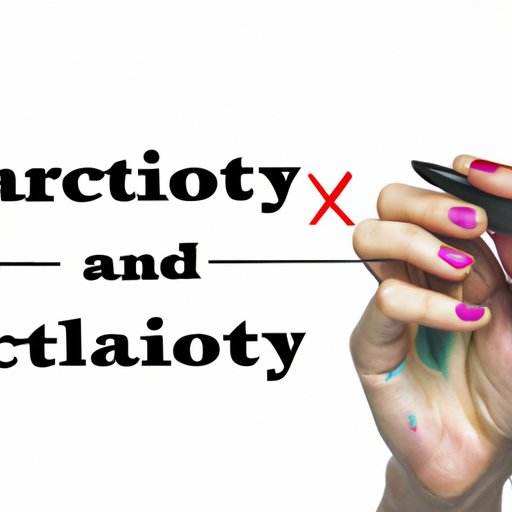Introduction
Handwriting tattoos have become increasingly popular in recent years as a way to honor a loved one or to preserve a meaningful message or note. Tattoo artists are often called upon to replicate someone’s handwriting as part of their tattoo design. But the question remains, can tattoo artists copy handwriting?
In this article, we will explore the legal and ethical implications of copying handwriting for tattoos, examine the challenges and limitations tattoo artists face in replicating handwriting, and provide alternative ways to honor loved ones without resorting to tattooing.
The Legalities and Ethics of Copying Handwriting in Tattoos
When it comes to copying someone else’s handwriting, there are legal and ethical considerations to take into account. From a legal standpoint, handwriting can be copyrighted if it’s original work. It’s important to understand the copyright laws surrounding handwriting tattoos to determine whether it’s legal to use someone’s handwriting for a tattoo.
Ethically, it’s essential to consider whether the person who wrote the handwriting would be comfortable having their work replicated for a tattoo. While consent isn’t legally required, it’s essential to respect someone else’s intellectual property and moral beliefs. Tattoo artists must have conversations with clients that include asking for and obtaining consent to copy the handwriting, as well as discussing the moral implications of doing so.
Is It Possible for Tattoo Artists to Perfectly Replicate Handwriting?
While tattoo artists often can replicate handwriting, there are challenges and limitations they face in doing so. One of the main hurdles in copying handwriting is the typeface used in the original writing. The way each person writes letters can vary significantly, and it can be challenging to create a universal typeface for each character.
The skin is also a challenging medium to work with, and some artists may not be able to use the same techniques they would use on other materials. Some solutions to these problems include scaling the handwriting up or down to make it easier to tattoo and simplifying more complicated script into a stencil for easier replication.
The Story of Handwriting Tattoos: From Personal Letters to Permanent Art
While handwriting tattoos have become increasingly popular in recent years, they have been around for quite some time. In the late 1800s, sailors would get tattooed with text from their love letters to keep the sentiment close to them during their travels. Today the trend has become a more permanent way to memorialize a loved one, and some people opt to tattoo a message from a loved one who has passed away.
Many people getting handwriting tattoos also use them to commemorate important dates such as anniversaries, weddings, and births. Handwriting tattoos offer a way to make these dates and personal messages a more permanent part of one’s life.
Exploring the Growing Trend of Handwriting Tattoos and Their Limitations
Handwriting tattoos have become an increasingly popular trend in the tattoo industry. Many people are attracted to them because of their deep personal significance. However, there are limitations and risks to getting a handwriting tattoo. One of the primary concerns is that the accuracy of the handwriting can vary over time as the skin ages and wrinkles.
Another limitation of handwriting tattoos is that they are not easily edited or removed. Unlike other types of tattoos, which can be altered or removed if needed, handwriting tattoos are a permanent and irreversible part of the skin. It’s essential to thoroughly consider the long-term implications of getting a handwriting tattoo before making the decision.
Understanding the Challenges of Tattooing Handwriting and Maintaining Accuracy
One of the critical aspects of getting a handwriting tattoo is ensuring that it’s accurate and true to the original writing as possible. One way to ensure accuracy is to scan or photograph the original handwriting and use it as a reference for the tattoo. Additionally, tattoo artists can use a stencil to ensure that each letter matches the original handwriting as closely as possible.
If the handwriting is small or complicated, some tattoo artists may choose to use an alternative method for etching the writing, such as etching it with white ink onto the skin and then tattooing over it. There are many creative techniques to ensure that the handwriting is true to the original while still producing a beautiful tattoo that will last for years to come.
Alternatives to Copying Handwriting in Tattoos: Creative Ways to Honor Loved Ones
If someone isn’t interested in getting a handwriting tattoo, there are still plenty of other ways to honor a loved one’s memory or preserve a meaningful message. One option is to engrave the writing on a piece of jewelry like a pendant or ring. Another idea is to frame the original handwriting and display it in the home.
For those who still want a tattoo, incorporating the handwriting into other designs can be an excellent way to add a personal touch. Tattoo artists can use handwriting as a way to insert a meaningful word or phrase into a more intricate tattoo design.
Conclusion
Copying handwriting for tattoos is something that tattoo artists can do, but it should be approached with care and consideration. It’s important to respect copyright laws, obtain proper consent, and consider the ethical implications of replicating someone else’s handwriting.
Despite the challenges, handwriting tattoos continue to be a growing trend in the tattoo industry. With careful consideration and the right techniques, tattoo artists can produce some beautiful and meaningful permanent art that commemorates a loved one or an important message.
(Note: Is this article not meeting your expectations? Do you have knowledge or insights to share? Unlock new opportunities and expand your reach by joining our authors team. Click Registration to join us and share your expertise with our readers.)
